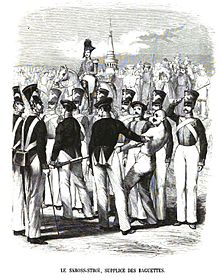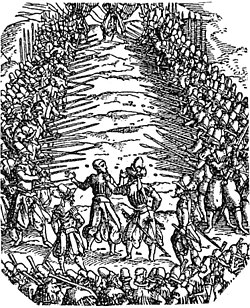Running the gauntlet

Torun the gauntletmeans to take part in a form ofcorporal punishmentin which the party judged guilty is forced to run between two rows of soldiers, who strike out and attack them with sticks or other weapons.
Metaphorically, this expression is also used to convey a public trial that one must overcome
Etymology and spelling[edit]
The wordgauntletoriginates fromSwedishgatlopp,fromgata'lane' andlopp'course, running'.[1]It wasborrowedinto English in the 17th century, probably from English and Swedish soldiers fighting in the Protestant armies during theThirty Years' War.The punishment itself was rarely used in theSwedish Armyduring the reign of the monarchGustav IIIin the 1770s and was abolished in theSwedish Armyin 1851.[2][3][4][5][6]
The word in English was originally spelledgantelopeorgantlope,[7]but soon its pronunciation was influenced by theunrelated wordgauntlet,meaning an armored glove, derived from theFrench:gantelet.[1]The spelling changed with the pronunciation. Both senses ofgauntlethad the variant spellinggantlet.[1]For the punishment, the spellinggantletis preferred inAmerican Englishusage guides byBryan GarnerandRobert Hartwell Fiske[8][9]and is listed as a variant spelling ofgauntletby American dictionaries.[1][10]British dictionaries labelgantletas American.[11][12]
Usage and severity[edit]

A naval version of the gauntlet was historically used in theRoyal Navyas a punishment for minor offences such as leaving the crew berths in an unsanitary state, or failing to return on time from leave. The condemned was ordered to make a prescribed number of circuits around the ship's deck, while his shipmates struck him with improvised versions of thecat o' nine tails.[13]Runs of the gauntlet could also be preceded by a dozen lashes from the boatswain's cat o' nine tails, so that any subsequent blows from the crew would aggravate the lacerations on his back.[14]The effectiveness of the punishment would somewhat depend on the popularity of the sailor being punished, and the seriousness of the offence. In 1760, Francis Lanyon, a seaman aboard the guardshipHMSRoyal George,was sentenced to three runs of the gauntlet, for failing to return from leave. The crew clearly disagreed with the punishment, as the ship's lieutenant later recorded that Lanyon received no substantive injury from the process.[13]The naval punishment of running the gauntlet was abolished by Admiralty Order in 1806.[14]
In the early records of the Dutch colonial settlement ofNew Amsterdamappears a detailed description of running the "Gantlope/Gantloppe" as a punishment for the "Court Martial of Melchior Claes" (a soldier). It states "... The Court Marshall doe adjudge that hee shall run the Gantlope once the length of the fort, where according to the Custome of that punishment the souldyers shall have switches delivered to them with which they shall strike him as he passes through them stript to the wast, and at the fort gate the Marshall is to receive him and there to kick him out of the Garrison as a cashiered person where hee is no more to returne..."[15]
Native American usage[edit]

SeveralNative Americantribes of theEastern Woodlandscultural area forced prisoners to run the gauntlet (seeCaptives in American Indian Wars).[citation needed]The JesuitIsaac Jogueswas subject to this treatment while a prisoner of theIroquoisin 1641. He described the ordeal in a letter that appears in the bookThe Jesuit Martyrs of North America:"Before arriving (at the Iroquois Village) we met the young men of the country, in a line armed with sticks...", and he and his fellow Frenchmen were made to walk slowly past them "for the sake of giving time to anyone who struck us."[16][full citation needed]
In 1755, Charles Stuart was taken prisoner byLenapewarriors during theGreat Cove massacre,and upon arriving at the village ofKittanning,was forced to run the gauntlet. He provides a description of the practice:
on Entring into the Town we were obliged to Pass Between Two Rows of Indians Containing abt 100 on Each Side, who were arm'd with various kind of Weapons such as Axes TomhawksCutlassesHoop Poles, Pieces of Wood &c, But they did not strike with the Axes, and only Used the Heads and Handles of their Tomhawks, But used the Blades of the Cutlasses, tho' not with so much Severity as To Kill. I had however the Misfortune to receive a Blow on the Side of my Forehead With one of them wch Cut me To the Bone, & a Billet of Wood Strikeing on the Head abt the Same time, Between Both I was Knock'd down to the Ground - It was, only the more elderly People both, Male and Female wch rece'd this Useage - the young prisioners of Both Sexes Escaped without it.[17]: 66
Many years before he became a hero of theAmerican Revolutionat theBattle of Bennington,John Starkwas captured by natives and forced to run a gauntlet. Knowing what was about to happen Stark stunned them by grabbing the weapon away from the first person about to strike him and proceeded to attack the warrior with it. The warriors and the chief were so surprised by this that they stopped the gauntlet and adopted him into their tribe. He was later ransomed along with Amos Eastman for $163 and returned home.[18]
Modern use[edit]
Fitness trailin communist Poland[edit]
During the days of thePolish People’s Republic,thecommunistauthorities forced political dissidents, criminals, protestors, and prisoners through a gauntlet-like process, which they called theścieżka zdrowia(literally 'health path', but idiomatically used to mean earlyfitness trails).
InKOR, A History of the Worker's Defense Committee in Poland, 1976–1981,Jan Józef Lipskidocuments the experience of one such criminal during theJune 1976 protests:
On the first day I walked the "path of health" on the way from a truck to the police van, about 50 metres. They ordered me to walk slowly so that each one could hit me. They beat me with fists, clubs, boots. At the very end, I fell down. I couldn't get up again under the hail of clubs... A "path of health" from the van to the second floor... When they took us to get haircuts – another "path of health" some 40 metres long, from the door of the room all the way to the car... Yet another 10 metres in the corridor leading to the table... Then, a "path of health" (10 metres) to cell number nine... to the court in a prison truck; of course another "path of health"... then again a "path" from prison to prison. I survived another "path of health" in the morning when they took me to Kielce.
— Waldemar Michalski,[19]
Military custom[edit]
Similar practices are used in other initiations and rites of passage, as onpollywogs(those passing the equator for the first time[20]includes a paddling version)
In oneTailhook Associationconvention forNavyandMarine Corpspilots, female participants were allegedly forced to run the gauntlet in a hotel hallway as male participants fondled them.[21]
Sports[edit]

In certain team sports, such aslacrosseandice hockey,the gauntlet is a common name for a type of drill whereby players are blocked or checked by the entire team in sequence.[22]
InBrazilian jiu-jitsu,when a student is promoted to their next coloured belt, they are sometimes required to run between two rows of their fellow students, who strike them with their own belts.[23]
See also[edit]
References[edit]
- ^abcd"gaunt·let2also gant·let ".American Heritage Dictionary.Retrieved24 March2015.
- ^"Online Etymology Dictionary".2011-01-04.Retrieved2011-01-04.
- ^Merriam-Webster's Collegiate Dictionary, 2004, "Gantelope"
- ^Merriam-Webster's Collegiate Dictionary, 2004, "Gauntlet"
- ^Word Origins, 2005, A&C Black, "Gauntlet"
- ^Word Histories and Mysteries, 2004, Houghton Mifflin, "Gauntlet"
- ^Maddox, Maeve."Running the Gamut and Running the Gauntlet".www.dailywritingtips.com.Retrieved20 April2017.
- ^Garner, Bryan (2009)."gantlet; gantlope".Garner's Modern American Usage(3rd ed.). Oxford University Press. p. 385.ISBN978-0199888771.
- ^Fiske, Robert Hartwell (2006). "Gauntlet".The Dictionary of Disagreeable English(Deluxe ed.).
- ^"gantlet".Merrian-Webster Online Dictionary.Retrieved18 September2013.
- ^"gantlet".Collins Dictionary.Retrieved18 September2013.
- ^"gauntlet2".British & World English dictionary.Oxford dictionaries. Archived fromthe originalon September 29, 2016.Retrieved12 September2018.
- ^abRodger, N. A. M. (1986).The Wooden World: An Anatomy of the Georgian Navy.Annapolis, Maryland: Naval Institute Press. pp. 227–228.ISBN0870219871.
- ^abThe Oxford Companion to Ships and the Sea,Peter Kemp ed., 1976ISBN0-586-08308-1
- ^Peter R. Christoph, ed., New York Historical Manuscripts: English, Vol. 22, "Administrative Papers of Governors Richard Nicolls and Francis Lovelace, 1664–1673," (Baltimore: Genealogical Publishing Co., 1980), pp 163–64. 22:123 [Minutes of the Court Martial of Melchior Claes, accused of theft]... held at Fort James the 28th day of December 1671
- ^"The Jesuit Martyrs of North America", The Universal Knowledge Foundation, c. 1925, p. 163.[full citation needed]
- ^Beverly W. Bond, "The Captivity of Charles Stuart, 1755-57,"The Mississippi Valley Historical Review,Jun., 1926, Vol. 13, No. 1, pp. 58-81
- ^Caleb Stark, John Stark,Memoir and Official Correspondence of Gen. John Stark: With Notices of Several Other Officers of the Revolution. Also, a Biography of Capt. Phinehas Stevens and of Col. Robert Rogers, with an Account of His Services in America During the "Seven Years' War."G.P. Lyon, 1860
- ^ KOR, A history of the Worker's Defense Committee in Poland, 1976–1981, by Jan Jósef Lipski, Translated by Olga Amsterdamska and Gene M. Moore, University of California Press, 1985, page 35
- ^The U. S. S. West Virginia: Crossing the Equator,West Virginia Division of Culture and History
- ^Office of the Inspector General (31 December 2003).The Tailhook Report.MacMillan.ISBN978-0-312-30212-2.Retrieved2009-05-22.
- ^"The Drill – Running the Gauntlet".CBC. Archived fromthe originalon 2013-07-25.Retrieved2012-07-10.
- ^"The Gauntlet (Belt Whipping)".BJJ Heroes.Retrieved2018-07-27.
